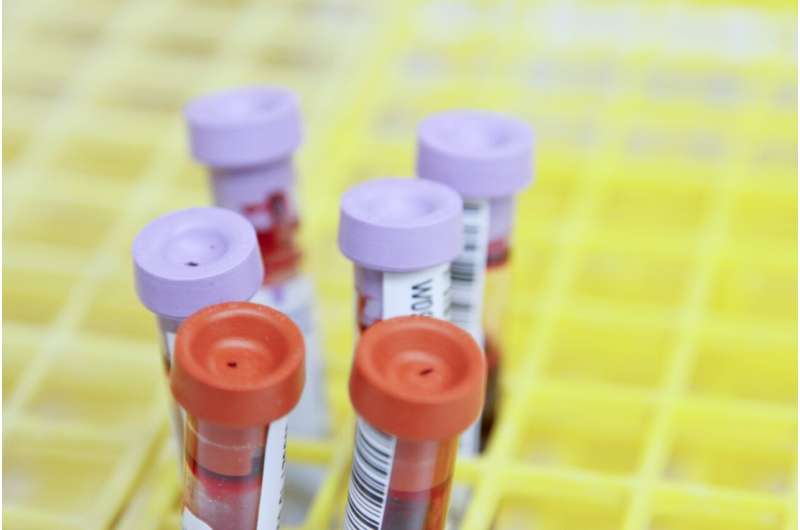This article has been reviewed according to Science X's editorial process and policies. Editors have highlighted the following attributes while ensuring the content's credibility:
fact-checked
peer-reviewed publication
trusted source
proofread
Inflammation levels tied to severity of blood cancer

Severe inflammation weakens the body's ability to kill cancerous blood cells in people with acute myeloid leukemia (AML), a new study shows.
Experiments in human cells also revealed how increasing levels of inflammation, marked by an aggressive reaction of immune cells in the bone marrow, altered the makeup of immune B cells and T cells needed to fight the disease like it would an invading bacteria or virus.
Using bone marrow samples of 20 adults and 22 children with the deadly disease, researchers at NYU Langone Health and its Perlmutter Cancer Center were able to score each patient's level of inflammation. These "iScores" were then correlated to survival rates, with those having the lowest iScores typically surviving the longest. Leukemic patients with high iScores died at least four years earlier than those with low levels of inflammation.
The new "iScore" system can be added to existing tools for measuring AML severity and used by physicians and patients when deciding on immunotherapy, chemotherapy, or bone marrow transplantation, the NYU researchers say.
"Our scoring system provides an easy tool for physicians and patients to measure their risk from inflammation tied to their leukemia and to adjust their treatment plans accordingly to manage this risk," says study co-lead investigator Audrey Lasry, Ph.D.
Measurements needed to calculate a patient's iScore, she says, are freely available in the study manuscript to academic researchers and clinicians, and published in the journal Nature Cancer online Dec. 29, 2022.
Lasry, a postdoctoral fellow at NYU Grossman School of Medicine and Perlmutter Cancer Center, says some patients in consultation with their medical providers may favor immunotherapy to boost immune cells needed to fight cancer if their inflammation score is high. Others may favor alternative therapies in cases of low inflammation tied to their cancer because their immune system does not necessarily need reinforcement.
The study also showed that bone marrow levels of dysfunctional (atypical) immune B cells were also linked to inflammation in both adults and children with AML.
A dozen gene mutations, or errors in the genetic code, were found to be tied to high iScores and patients with severe cases of the disease.
Another key finding was that the effectiveness of some immune T cells, which directly attack cancer cells, was suppressed in child cases of leukemia with high inflammation but not in adult cases with high inflammation.
"Our study provides the first detailed description of how inflammation alters the tumor microenvironment in acute myeloid leukemia in both adults and children," says study co-lead investigator Bettina Nadorp, Ph.D., also a postdoctoral fellow at NYU Grossman School of Medicine and Perlmutter Cancer Center.
"These study findings suggest that monitoring inflammation in patients with AML and possibly lowering inflammation levels with drug therapy should be considered as part of treatment for the disease," says study senior investigator Iannis Aifantis, Ph.D.
Aifantis, the Hermann M. Biggs Professor and chair of the Department of Pathology at NYU Grossman and Perlmutter, says the team plans to analyze bone marrow samples from people with myelodysplastic syndrome, another blood cancer related to acute myeloid leukemia, to see if the same risk stratification applies based on inflammation.
For the investigation, researchers compared bone marrow samples from patients with acute myeloid leukemia to bone marrow samples from 10 healthy people who did not have cancer but were of similar age, race, and gender.
Some 246 genes tied to inflammation were found to be highly or less active in adults with the disease, while 187 genes linked to inflammation similarly stood out among children. By factoring in how long each patient lived with the disease, researchers narrowed their analysis to 38 relevant genes in adults and 11 in children and were then able to calculate a score that tied inflammation levels to survivability. When a number of patients' iScores was compared, researchers say it is easy to see whose iScore is above or below average and by how much, information which can then be used to guide a patient's treatment.
The research team has a patent application pending for the iScore for any commercial activity resulting from its use. The terms and conditions of this patent are being managed in accordance with the policies of NYU Langone.
Acute myeloid leukemia originates in the bone marrow and involves the buildup of abnormal blood cells, which can interfere with production of healthy blood cells. The common blood cancer occurs mostly in adults, resulting annually in the deaths of more than 11,500 Americans. Treatment options include chemotherapy, radiation, and immunotherapy. Bone marrow transplantation can also be considered if other options fail.
More information: Audrey Lasry et al, An inflammatory state remodels the immune microenvironment and improves risk stratification in acute myeloid leukemia, Nature Cancer (2022). DOI: 10.1038/s43018-022-00480-0





















